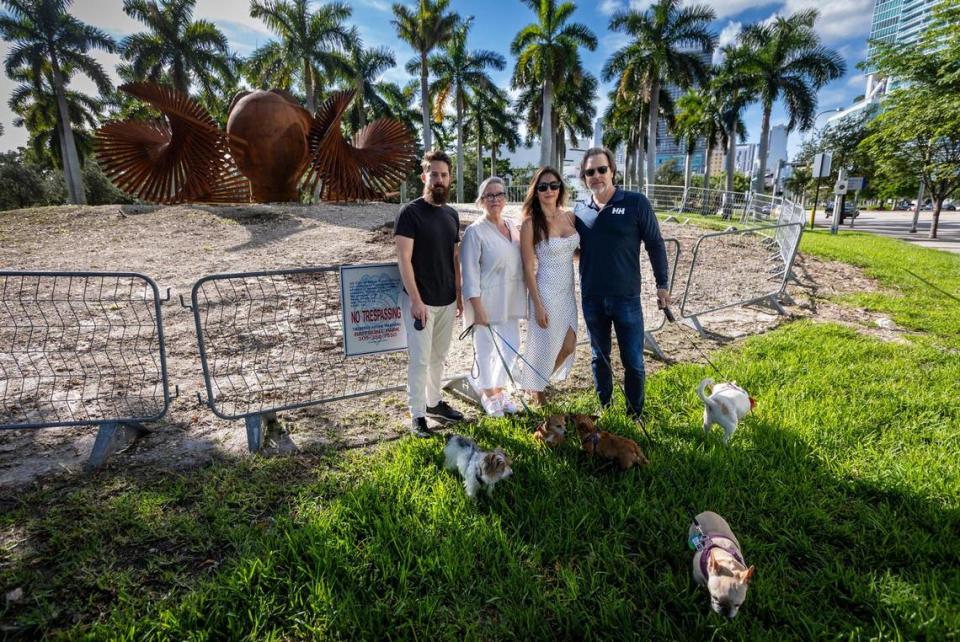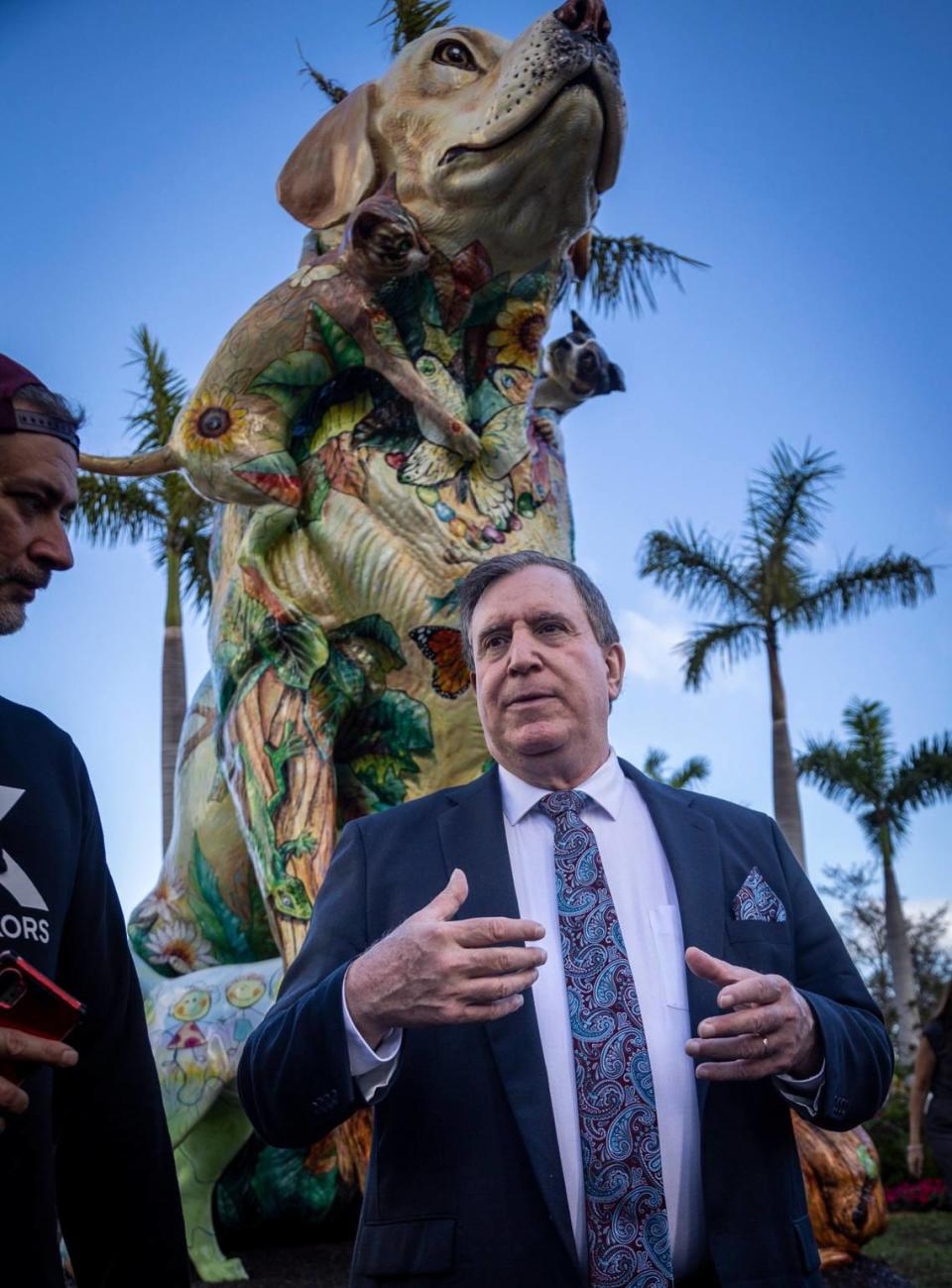A giant tree in Miami waterfront park was chopped down by the city — without city approval
A 35-foot tall ficus tree thought to be among the oldest in Maurice A. Ferré Park was chopped down by the city of Miami without any advance notice or a removal permit.
What will take the beloved tree’s place? The city claims an oak tree will go there. But downtown residents who use the park daily dread the planting of an invasive species — a 300-square-foot electronic billboard blinging ads.
It’s a sign of the times, they say
“The corruption in our city is so brazen that they think they can make a beautiful tree in a prominent public space disappear and get away with it,” said Candace O’Brien, who lives across Biscayne Boulevard from the park, where she walks her two rescue dogs. “First the city approves billboards in parks. That’s absurd. Then they remove a huge tree to make room for an ugly billboard. That’s disgraceful.”
O’Brien has been requesting answers from city officials since the tree, located at the southeast corner of Northeast 11th Street and Biscayne Boulevard, was taken down in July. She has contacted Miami Mayor Francis Suarez, District 2 Commissioner Sabina Covo, Building Department Director Asael Marrero, Environmental Resources Chief Quatisha Oguntoyinbo-Rashad and the executive director of the Bayfront Park Management Trust, which oversees Bayfront Park and Ferré Park, formerly known as Bicentennial Park and Museum Park.
City Commissioner Joe Carollo is chair of the nine-member Trust board.
No one from the city has provided what she considers justification for destruction of the tree, O’Brien said, or the cost to taxpayers. The first of her many emails, entitled “Extraordinary incompetence, arrogance and illegal behavior by the City of Miami,” was sent seven weeks ago.
Treegate, which began with a permit application rife with inaccuracies that was never approved, is just one example of the paving of paradise at the bayfront oasis envisioned as Miami’s version of New York’s Central Park, say angry neighbors.

Neighbors upset with Carollo
The neighbors blame Carollo, who has long heard complaints that he runs the two parks as he would a private personal estate, with Trust board members rubber-stamping his ideas, whether it’s a dog run area covered with synthetic turf, an outdoor gym, or the “Dogs and Cats Walkway” lined with brightly painted metal statues. Love or hate the promenade of 3-foot-tall Chihuahuas and 6-foot-tall German shepherds, it was installed at a cost of $1 million despite no public vote.
Carollo is also contemplating a pickleball court and soccer field and previously proposed a boatyard, marina and restaurant in Ferré Park, which was designed by a premier landscape architecture firm to be a green park on Biscayne Bay. The plan called for a great lawn, a baywalk, plentiful shade, fountains, flower, palm and children’s gardens, an islet in the basin on its south border, and a soccer field on Parcel B behind the Miami Heat’s arena. Many of the features, estimated to cost $45 million in 2008 and to be finished by 2011, have never been implemented.
Ferré Park is named after the late six-term mayor of Miami, Maurice A. Ferré, who called the monetizing of public green space — he referred to the basketball arena on the waterfront and the then-proposed soccer stadium and mall in Melreese Park — “an act of negligence.” The park is 28 acres in size, with the Frost Museum of Science and the Pérez Art Museum Miami occupying 12 acres.
“The park is under constant assault,” said Claudia Roussel, who lives across the street, has battled Carollo for years and started a petition drive to oust him as Trust chair. “We only find out what’s happening when the cement trucks arrive.”

Carollo: Making the park ‘inclusive to everyone’
Carollo is tired of the attacks on his aesthetic taste, his character and his motivation, he says. He only wants to improve the parks, and find ways to generate the money necessary for improvements when budgets are tight.
He wants to get things done — the Torch of Friendship was fixed under his watch and he’s working on a solution for the Noguchi-designed Mildred and Claude Pepper Fountain that has been bone dry for 15 years. He wants the parks to be used by all Miamians, not just wealthy, high-rise condo dwellers.
“A small group of elitists has been complaining since before I was chair,” Carollo said. “I’m bringing in activities and attractions to make Ferré Park inclusive to everyone — from Overtown, Little Havana, Allapattah — who deserves to enjoy it.
“These whiners spread false, malicious information even though everything passes by the board in public hearings.”

Yet Michael Feuling, who has lived in the 900 Biscayne building for 10 years and attends board meetings, was surprised to come upon the construction of an outdoor gym last month. He saw no posted permit so asked a worker to see it. He was told to go away.
An employee from the Trust office drove to the site in a golf cart and took photos of him, he says. Feuling then contacted the city’s Code Compliance Department and Covo. When he got a copy of the permit a week later, the contractor’s name was redacted.
Cement was poured for the gym slab last Thursday. Equipment was installed the next day.
“It’s built fast so it will be too late to stop it,” Feuling said. “It takes up green space and nobody will use it. Another Joe project, like the kitschy dogs and cats. I told him, ‘Joe, you won’t be satisfied until you turn this place into Coney Island.’
“This invaluable land was supposed to be a world-class park for a world-class city, but we have one autonomous politician doing whatever he wants with a public asset.”
Carollo’s response: “What kind of a Grinch is opposed to outdoor exercise equipment? I’m in the park a lot, and I see how the dog and cat sculptures are a popular draw.”
Park regulars were also surprised when original limestone benches arrayed along the slip recently disappeared, replaced by brick-bordered patches sprouting Crown of Thorn plants.
“They look like cemetery plots,” Roussel said.
When Roussel, Feuling and Downtown Neighbors Alliance President James Torres implored Covo to get involved in park issues in her district, she replied, “’That is not my job. It is political and mine is a non-political position,’” Roussel, Feuling and Torres said. Covo could not be reached by the Herald.
Residents fear the Trust is “operating to significantly change the character of Maurice A. Ferré Park without receiving input from the community,” the alliance said in a letter to the Trust.
The advocacy group cited shoddy and unsafe “irregularities” in the installation of light poles, sculptures and shipping containers that are performance spaces for Micro Theater Miami.
“Permits for construction, for the most part, seem non-existent,” wrote Torres, who is running for Covo’s seat in the Nov. 7 Miami election.
“The master plan is not respected while Joe Carollo builds his no-bid, pet projects,” Torres said. “We just want a seat at the table.”
Alliance and community members are meeting with city officials on Nov. 1 to request a halt of all construction until it is reviewed.
Downtown residents are still upset at the Trust for cutting security guard patrols four years ago. About 100 homeless people were living in the park until security was reinstated in November 2022, after some condo homeowners’ associations agreed to help defray the cost.
Carollo said the Trust has upgraded maintenance at the park and plans to plant 150 trees next year.
“We’ve cleaned it up,” he said. “I deliver.”
The removal of the ficus tree
One tree that can’t be replaced is the ficus, or strangler fig, that was at the corner of Northeast 11th Street next to the sculpture entitled “pi.” That piece was moved south to a spot next to the Miami-Dade Water and Sewer facility. In its place, a sculpture by Spanish artist Manolo Valdes has been installed by the Trust. Carollo said Valdes gave it to the park after it had been displayed in London, Rome and Paris.
Some people fancy the Valdes sculpture, some don’t, but they don’t understand why the tree was removed.
“This tree served as a symbolic gateway, ushering us from the city into a more natural world,” said Julie Manrique, who lives across the street from the park. “It is profoundly immoral to sacrifice such an established and healthy tree simply to make way for another man-made object, whether it be a sculpture or a billboard.”
Carollo said the tree was removed because its roots presented a tripping hazard and prevented anything from being planted around it. And, “its seedlings wind up in other trees and strangle them — that’s why they’re called assassin trees,” he said.
“That’s an excuse,” said O’Brien, who has found no history of tripping complaints, and argued that if it were a hazard, fencing could have been placed around it.
“I cannot fathom how, in a city park of all places, a perfectly viable and magnificent part of our tree canopy was destroyed without any permit or authorization from the City of Miami -- and by the City of Miami,” O’Brien wrote to Mayor Suarez. “In your whole, presidential scheme of things, you probably believe this is a trifling matter that does not warrant your attention, much less any action. Time will tell whether my theory is correct.”
After the tree was chain-sawed and hauled away, a concrete slab was poured atop the surrounding knoll. But, again, no barriers or warning signage was erected and no city permit was obtained.
An 8-year-old boy ran up the hillock and fell into the pit of wet cement by accident on Aug. 15. He wasn’t injured, according to a story in Miami New Times, which ran a photo of the boy covered up to his chest in gray slop.
When the boy’s father and the alliance complained to the Trust, interim director Miguel Ferro responded that the boy must have fallen into another hole because the one in Ferré Park had barriers around it. The father and park neighbors were incensed by the reply because there had never been barriers around the construction site. In fact, one of the boy’s sandals was swallowed up by the pit, and Ferro could scoop it out for proof, the father said.
The Valdes sculpture now sits on the concrete base.
“The city of Miami needs more grass and trees, not more concrete,” said Peter Ehrlich, president of the Urban Environment League and co-founder of Scenic Miami, who added that Miami consistently ranks last in park space per capita in U.S. surveys. “The news that city employees and Trust employees were complicit in killing a beloved tree is disturbing.”
Billboards are coming to the park
Billboards will indeed be the newest objects in the park, Carollo acknowledged last Friday — one on the north end and one on the south end, both facing Biscayne Boulevard, on the east side of the sidewalk. While it’s unclear if one of the LED signs will be placed on the exact spot where the tree stood, it will be close by, and unobstructed by the tree’s 40-foot-wide canopy as some 100,000 motorists pass by each day.
“Advertisers want visibility and eyeballs,” Feuling said. “Just wait. Carollo is going to put one on the baywalk where thousands of cruise ship passengers can see it.”
Although a proposal to put 45 digital billboards in Miami’s core was recently defeated by commissioners because of a public backlash, the placement of LED billboards in Ferré Park, Bayfront Park, Virginia Key Beach Park and at Miami Off-Street Parking facilities was approved Feb. 9 by a 3-1 vote, with Manolo Reyes opposed — warning, “we don’t want to look like Vegas.”
The two in Ferré Park — on monument bases and up to 400 square feet in size — will generate $800,000 in annual revenue from outdoor advertising companies. The city can’t afford to let its prime real estate sit idle, said Carollo, who proposed filling in the boat slip when he was mayor. He’s not worried about billboard blight.
“That income is vital for Ferré Park because it depends on funds from Bayfront Park activities to maintain itself,” Carollo said. “The complainers should look at the buildings they live in that are plastered with huge advertising banners.”
Permit for tree removal had issues
As for the Trust’s tree removal application, it contained an incorrect tree location (listed was the address of the county water and sewer facility 60 yards away). On the signature page, then-Trust executive director Frank Rodriguez signed on behalf of the applicant, which he incorrectly named as the water and sewer department, with the department’s main office address. And he used a bogus email: Uknown@gmail.com.
O’Brien wants to know why the arborist’s report stating that the tree was viable and could be moved was ignored. She also wants to know how much the job cost and why the contractor, Nicolas Bofill of The Native Guy, took down the tree without a permit.
On his website, Bofill describes his primary business as a beekeeper who sells honey, but he is also an experienced landscape contractor with a local business tax license and he is a certified professional horticulturist. Bofill, who transplanted trees from the old science museum by Vizcaya to the new one in Ferre Park, and installed landscaping around the new museum, said he thought the permit application he filled out was “preliminary, unfinished paperwork,” and was surprised to be told by Rodriguez that it was processed and approved. Bofill said he simply carried out the Trust’s work order instructions.
Bofill lists his company’s mailing address as 6619 S. Dixie Highway, a strip mall in Miami where he has a post office box, which is the same mailing address listed on campaign finance reports for billboard company lobbyist and former Miami commissioner Marc Sarnoff’s political committee, Truth is the Daughter of Time. Bofill said he doesn’t know Sarnoff and has no connection to the committee. Sarnoff’s committee donated $20,000 from billboard companies to Covo’s campaign last quarter.
Carollo said mistakes were made in the permitting process. The Trust considered removing three trees in a cluster at Northeast 11th Street — the ficus, a 25-foot tall gumbo limbo and a 40-foot tall black olive.
The city’s Environmental Resources department gave preliminary approval to relocate the gumbo limbo, but was awaiting more information before granting a permit for the ficus.
“There was a mix-up and the Trust’s executive director went ahead and had the ficus removed before the permit was approved,” Carollo said. “Our people are human and they are trying to do their best.”
The Trust is taking “steps to complete the after-the-fact tree permit,” Marrero, the city’s building department director, wrote to O’Brien. “They have since provided incident reports of tripping incidents and is working to complete and submit the Landscape Plan that shows adequate replacement of the tree.”
And so Treegate festers. Ferré Park devotees stroll toward the bay and wonder what’s next.
Miniature golf, anyone?
“Let’s not give Joe Carollo any ideas,” Feuling said. “But I wouldn’t be surprised to see a go-kart track.”


